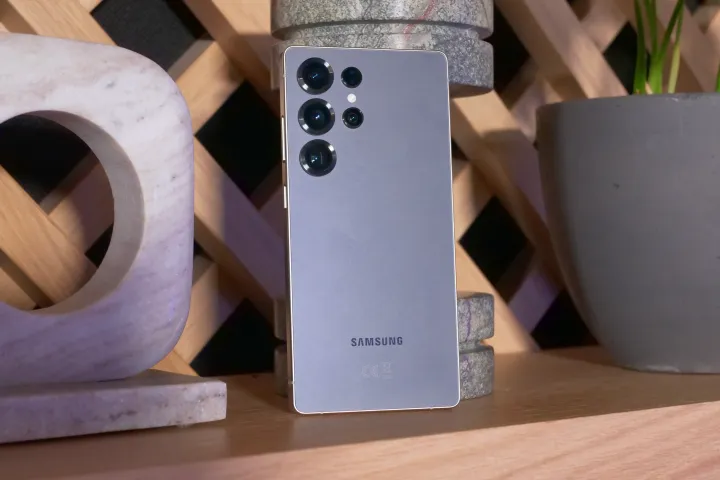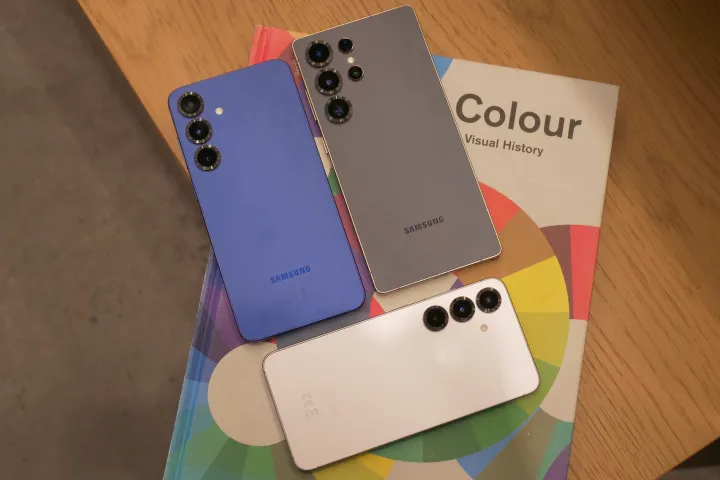Samsung’s flagship lineup for 2025 has arrived, with three new phones landing. On top of the line sits the Samsung Galaxy S25 Ultra, one of the mightiest contestants for head position in our best phones list. Right underneath it is the Galaxy S25 Plus, which gets the basics right while excluding some luxury features from the Ultra. Samsung’s improved AI functionality gives us a glimpse of what phone upgrades may look like in the coming years.
Both the Galaxy S25 Ultra and the Galaxy S25 Plus run the best Samsung hardware and software, but the Ultra adds extra bits such as an anti-reflective display, a 5X telephoto camera, and the useful S Pen. However, with a $300 chasm between them, there is definitely room for pondering if those features aimed at specific users are really worth the extra expenditure.
Below, we will chew over those similarities and differences to help you decide whether you should go for the more practical S25 Plus or go all in with the expensive S25 Ultra.
Samsung Galaxy S25 Ultra vs. Galaxy S25 Plus: specs
| Samsung Galaxy S25 Ultra | Samsung Galaxy S25 Plus | |
|---|---|---|
| Size | 162.8 x 77.6 x 8.2mm (6.41 x 3.05 x 0.33) | 158.4 x 75.8 x 7.3mm (6.24 x 2.98 x 0.28) |
| Weight | 218 grams (7.69 ounces) | 190 grams (6.70 ounces) |
| Screen | 6.9 inches LTPO OLED, 1440 x 3120 pixels
1-120Hz HDR10+ 1,600 nits brightness, 4,500 nits peak brightness Gorilla Armor 2 |
6.7 inches LTPO OLED, 1440 x 3120 pixels
1-120Hz HDR10+ 1,600 nits brightness, 4,500 nits peak brightness Gorilla Armor 2 |
| Operating system | One UI 7 based on Android 15 | One UI 7 based on Android 15 |
| RAM & Storage | 12GB + 256GB (UFS 4.0)
12GB + 512GB 12GB + 1TB |
12GB + 256GB (UFS 4.0)
12GB + 512GB |
| Processor | Qualcomm Snapdragon 8 Elite | Qualcomm Snapdragon 8 Elite |
| Camera | Quad rear cameras:
200-megapixel primary, OIS 50MP ultrawide 10MP telephoto, 3x optical zoom 50MP periscope telephoto, 5x optical zoom Front camera: 12MP, f/2.2, autofocus |
Quad rear cameras:
50MP primary, OIS 12MP ultrawide 10MP telephoto, 3x optical zoom Front camera: 12MP, f/2.2, autofocus |
| Video | Rear: Up to 8K@30fps, 4K@120fps
Front: Up to 4K@60fps |
Rear: Up to 8K@30fps, 4K@60 fps
Front: Up to 4K@60fps |
| Connectivity | Bluetooth 5.4
5G Wi-Fi 7, dual-band Samsung DeX |
Bluetooth 5.4
5G Wi-Fi 7, dual-band Samsung DeX |
| Ports | USB-C Gen 3.2 Gen 1 | USB-C Gen 3.2 Gen 1 |
| Water resistance | IP68 | IP68 |
| Battery & charging | 5,000mAh with 45W wired charging
Wireless charging Reverse wireless charging |
4,900mAh with 45W wired charging
Wireless charging Reverse wireless charging |
| Colors | Black, Silver, Green | Black, Silver, Green |
| Price | Starting from $1,300 | Starting from $1,000 |
Samsung Galaxy S25 Ultra vs. Galaxy S25 Plus: design
The newly launched Samsung Galaxy Ultra and the Galaxy S25 Plus get limited improvements over previous generations. Of the two, the Ultra feels more radically changed, with curvier corners and flat rails around the edges (compared to the S24 Ultra). It is also the sole Samsung phone (among candy bars) to look distinct from the rest.
The Galaxy S25 Plus, on the other hand, feels overfamiliar since Samsung uses the same template for every phone apart from the Ultra and its foldables. Being the only Samsung phone with the distinct design, the Ultra definitely feels more attractive.
While the S25 Plus has also gone under the lathe for completely flat edges, the design doesn’t appear too from the last year’s phone. Compared to the Ultra, the Galaxy S25 Ultra’s corners are much curvier, which, in comparison, reduces the impact that the Ultra’s newly introduced curves have when you look at both phones side-by-side.
The Samsung Galaxy S25 Ultra and the S25 Plus are both massive phones, despite being leaner than respective predecessors. The S25 Plus is relatively smaller and noticeably lighter and should be your choice if you prefer convenience. With these phones, Samsung has reduced the bezels around their displays, which makes even the Galaxy S25 Ultra feel more ergonomic.
As with previous generations, the Galaxy S25 Ultra gets a dedicated S Pen slot while the S25 Plus doesn’t. The slot on the Ultra feels closer to the (now rounded) corner, and might feel slightly more accessible if you have used previous Note series or Ultra phones from Samsung.

Another key difference is the material used for frames. While The Galaxy S25 Ultra is furbished with a titanium frame, the S25 Plus gets a less suave recycled aluminum alloy in its place. The Ultra also uses a sturdier Gorilla Armor 2 to protect its glass back while the S25 Plus sticks to an older Gorilla Glass Victus 2. The newer glass is But otherwise, both phones have similar resistance to water and dust, with the same IP68 rating.
Samsung follows Apple’s strategy with colors for its phones, offering punchier and more saturated shades (of similar colors) on the S25 and the S25 Plus while offering muted versions on the Ultra.
With a distinct design, more durability, and subtle colors, the Galaxy S25 Ultra feels like a better choice here, unless you explicitly want a tall phone that does not feel heavy by any measure.
Winner: Galaxy S25 Ultra
Samsung Galaxy S25 Ultra vs. Galaxy S25 Plus: display

The displays on the Galaxy S25 Ultra and the S25 Plus are identical, unlike their design. The only apparent difference is their sizes, where the Galaxy S25 Plus gets a 6.7-inch screen, while the Ultra features a 6.9-inch panel.
Both displays have the same QHD+ resolution with 1440 x 3120 pixels. Both have the same LTPO AMOLED tech underneath and get an adaptive refresh rate up to 120Hz. The smaller size on the Plus corresponds to a slightly better sharpness on paper, though the difference won’t appear to the eyes.
Since the Galaxy S25 series is backed by AI upgrades, Samsung skipped bragging about the displays’ brightness. Since the displays themselves haven’t changed much since the S24 series, we expect the newer models to also have the same 2,600 nits of peak brightness. Both phones also get HDR10+ support for richer contrast when watching content on apps such as Apple TV+, Amazon Prime Video, Disney Plus. Unfortunately Netflix will not fully utilize this ability and scale back content to a more inferior HDR10 since its HDR content supports a rival codec, Dolby Vision. If you binge Netflix compulsively, you might want to consider a non-Samsung flagship, such as the OnePlus 13.

Besides the size, the only apparent difference between the displays on the Galaxy S25 Ultra and the S25 Plus is the protection on top. The Galaxy S25 Plus gets Gorilla Glass Victus 2 from a few years ago, while the Ultra gets the latest and more durable Gorilla Armor 2. The Armor 2 also brings an anti-reflective coating that will offer better readability than the Plus.
If you tend to cram the phone in the same pocket as your keys or other sharp objects, the Ultra might be better. But for other use cases, both displays are largely the same.
Winner: Tie
Samsung Galaxy S25 Ultra vs. Galaxy S25 Plus: performance

The Galaxy S25 series is fully powered by Qualcomm’s Snapdragon 8 Elite, making it one of the rare occasions when Samsung does not deploy the Exynos chips in certain markets. Both the Galaxy S25 Ultra and the S25 Plus are claimed by Samsung to use an overclocked “For Galaxy” version of the Snapdragon 8 Elite, with a slight boost over the variant that powers other flagships, including the OnePlus 13.
Samsung says the chipset offers roughly 40% better CPU and 30% better GPU performance over the previous generation, though the messaging applies to both phones. Likewise, the entire S25 series gets 40% larger vapor chambers to dissipate heat from the powerful chip. Samsung does not reveal the exact sizes of these chambers for each phone, but the Ultra can be expected to house a bigger unit due to its slightly bigger size.
Both the S25 Ultra and the Plus get 12GB of RAM as standard across all storage variants, though the Ultra also gets a 1TB option. Overall, the performance on both phones is likely to be neck and neck. So, if you are looking to choose between one of the phones purely for the performance, either should be good, though the S25 Plus will be a better value for money. For gaming, you might want to choose the phone that better suits your requirements for ergonomics and allows for prolonged usage.
Winner: Tie
Samsung Galaxy S25 Ultra vs. Galaxy S25 Plus: battery and charging

The Galaxy S25 Ultra and the S25 Plus have much in common when it comes to their battery backup and charging. There’s only a 100mAh difference between the battery capacities of both phones, with the Galaxy S25 Plus lagging with its 4,900mAh pack. The larger 5,000mAh battery on the Galaxy S25 Ultra is unlikely to make a considerable difference, especially when accounting for the increased power consumption of the slightly bigger display on the Ultra.
In terms of charging too, both Galaxy S25 Ultra and the Plus support charging speeds up to 45 watts. Although Samsung does not include a charger within the box, you can use any third-party charger that supports USB charging standards, including USB Power Delivery (USB-PD) and Programmable Power Supply — the latter of two is newer and more efficient.
The Galaxy S25 series is also among the first batch of mainstream phones apart from the iPhone to support the new Qi2 wireless charging protocol. We say mainstream since the HMD Skyline supports Qi2, but isn’t a phone most will have heard of. The standard allows for faster wireless charging with rates going up to 15W. However, unlike the iPhone and the Skyline, there are no magnets inside the Galaxy S25 series — since that is not an essential requirement for the Qi2 standard. That means you would have to rely on a case to get MagSafe-like functionality to both the Galaxy S25 Plus and the S25 Ultra.
Both phones also support reverse wireless charging but at a much slower rate. This can be used to charge other phones but is primarily useful for charging accessories, such as wireless earbuds.
Once again, little differences steer this comparison towards a tie.
Winner: Tie
Samsung Galaxy S25 Ultra vs. Galaxy S25 Plus: camera

The cameras on the Galaxy S25 Ultra are among its defining features and what set it apart not just from the Galaxy S25 Plus but the entirety of the Galaxy lineup. For one, there are four cameras on the back, including a 200-megapixel primary wide-angle, a 50MP ultrawide-angle, a 10MP telephoto with 3x optical zoom, and another 50MP shooter with 5X telephoto periscope. The assemblage of both a 3X and 5X telephoto makes the Galaxy S25 Ultra a rather unique phone, besides arming it for great photography.
The Galaxy S25 Plus, on the other hand, features a 50MP primary camera, a 12MP ultrawide-angle, and 10MP telephoto with 3X zoom. Even though the 10MP telephoto appears common on both phones, the Ultra’s 3X shooter uses a larger sensor, allowing for better-lit and sharper shots.
On the front, both phones get the same 12MP selfie camera with autofocus.

In theory, the Galaxy S25 Ultra is the better option if you want to capture more compelling images. From our early impressions, the camera is impressive. Moreover, the Galaxy S25 Ultra also gets smoother transition effects when zooming in or out. Meanwhile, the Galaxy S25 Plus isn’t lackluster in seclusion, though it will likely appear less attractive when images are compared to the Ultra.
Both phones also get AI enhancements that improve the image quality using generative AI models. Additionally, both can be used to capture RAW photos using Samsung’s Expert RAW app.
In terms of video, both phones can capture 8K videos at 30fps. While the Galaxy S25 Ultra can also capture 4K videos at up to 120fps, the S25 Plus is limited to 4K at 60fps — unless you’re recording a slo-mo, which enables the 4K 120fps mode on both phones. Besides regular videos, both phones can be used for recording with HDR10+ for wider dynamic range.
Samsung also brings an improved version of Audio Eraser to videos, which will allow you to remove distracting background noises — whether it’s just background noise, natural disturbance, or music — from videos recorded using the phones. It is available across the entire series.
Winner: Samsung Galaxy S25 Ultra
Samsung Galaxy S25 Ultra vs. Galaxy S25 Plus: software and updates

The Galaxy S25 Ultra and the Galaxy S25 Plus maintain parity in terms of their software experience. Both devices are among Samsung’s firsts to get the updated One UI 7 based on Android 15. Samsung also promises seven years of software updates for both phones.
While there aren’t significant hardware changes, the Galaxy S25 series gets improvements to its AI features. Covered in the limelight is Samsung’s new “Now Brief,” which, Samsung claims, is intended to work like a personal assistant. It is meant to grow as you spend more time with the phone and make your time with it easier. In short, it gives you personalized insights based on the time of the day. You can control the data it accesses from apps, giving you some flexibility over what you wish it to see.
This adds onto the already existing features such as Circle to Search, Live translations, AI generated messaging, and so on. To cherish these features, you would need to use Samsung’s own apps and sign into a Samsung account on your device.

It may still be a little early to wrap our heads around all the claims Samsung makes for its AI applications, but the theory seems fascinating. Thankfully, it doesn’t discriminate in terms of availability, and all S25 phones get similar functionality. Older phones might get it too, even though the S25 series would process requests faster because of a more capable neural processor.
Another chief attraction of One UI 7 is the Now Bar, which is a pill-shaped dynamic widget for the lock screen. It changes based on the app you are using — for instance, it can be a timer, a music player, etc., much like the iPhone’s Dynamic Island.
Since there is practically no difference in the software experience between phones, this tends to tie once more.
Winner: Tie
Samsung Galaxy S25 Ultra vs. Galaxy S25 Plus: price and availability

The Samsung Galaxy S25 Ultra starts at $1,300 for the 256GB variant, but you can get a 512GB variant for the same price if you pre-order the phone until February 7. The 1TB model is currently available for $1,420, but the prices will increase by $240 when the phones go on open sale.
The S25 Plus is priced at $1,000 for the 256GB variant, but Samsung is currently letting you upgrade to 512GB for as little as $20 during the pre-ordering period. Beyond that, you will have to pay $1,120 for the bigger storage variant.
Samsung Galaxy S25 Ultra vs. Galaxy S25 Plus: verdict

The Galaxy S25 Plus nails all the basics you would expect from a high-end phone. Besides superfast performance and bug-free software, it offers a promising set of AI tools that set it ahead of the similarly equipped flagships such as the OnePlus 13. The Galaxy S25 Ultra has extra bells and whistles on top that elevate its status as the more premium phone.
You would want to consider the Galaxy S25 Ultra if you want better build quality, an anti-reflective display (though with the same display quality), a better set of cameras, or the convenience of the S Pen. You also get the additional convenience of a terabyte of storage with the Ultra, which is missing from the storage options for the S25 Plus.
Meanwhile, the Galaxy S25 Plus is a better value for money. With a base price difference of $300, you can access similar AI features, equally good hardware and displays, slightly inferior but still great cameras, battery and charging solutions. Essentially both phones offer a similar premium experience, but the Ultra adds an extra touch of luxury. It totally depends on whether you want to spend an extra $300 on that or not.







